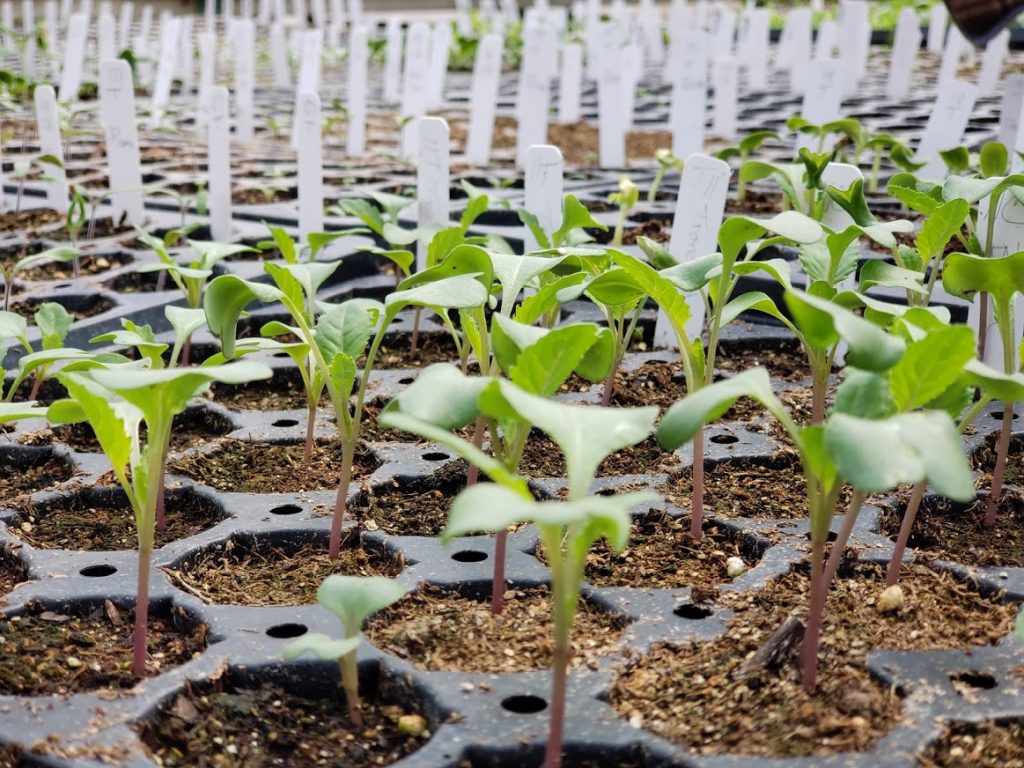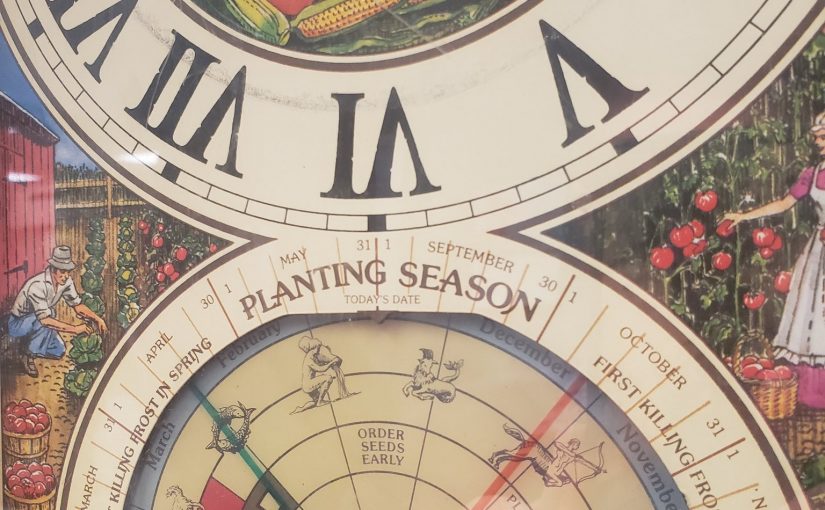It seems like we’re always adhering to one schedule or another these days. We have devices and planners to keep track of our appointments, our work schedules, kids schedules, and more. Heck, even the antique seed company clock in my office is telling me to order seeds. It can seem overwhelming, so you might laugh if I tell you that coming up with a schedule, or a plan, for your garden can be beneficial. It is especially helpful for vegetable gardeners or those who like to any kinds of seeds.
Developing a yearly plan for the garden can help you keep ahead of the big tasks, help you stay on top of issues like weather, as well as make sure you get seeds started on time and transplanting done when it makes the most sense. While some of this may be a review for seasoned gardeners, the number of questions and calls we receive at Extension (and the number of oopsies we see) means that the information could be helpful for many.
Since my background is in vegetable production, I’ll focus there with some bits and pieces added for ornamentals when they fit.
Do you have garden goals?
Whenever you are planning your annual vegetable garden, or planning on adding any ornamentals to your gardens or landscape, you should ask yourself a few simple questions. When you’re dreaming of your garden during the winter is a good time to think of these goals.
1. What are my goals for the garden? Do I have long-term goals? What short-term goals can you set for this year to build momentum toward your long-term goals?
2. What resources am I willing to invest in the plants I’m ordering (money, time, water, space)?
3. What are the things I most want to grow?
4. What has worked (and what hasn’t) in your garden in the past?
While it may sound funny to say that you are going to set goals for your garden, it really isn’t all that far-fetched.
If you are planning to add ornamental plants to your landscape, you should think about what you want from those plants — are you looking for color or for structure? how about perennials vs. annuals (or biennials)?
When you are planning a vegetable garden, you should ask yourself not only what you want to grow, but how much. Are you just planting for fresh-from-the-garden eating, or do you want to preserve some through canning, freezing or drying? Are you growing just enough potatoes to eat for a month or two after the garden season, or do you need to select a variety that keeps well so you can store it?
Tips for Planning a Successful Garden
After you set your goals and decide what you want to plant, developing a schedule of when to do what is a good idea to stay on top of everything. I can’t tell you how many years I had been planning on planting this or that, but then forget to buy what I need or start seeds on time. A plan can help with that, as well as helping you space activities out over time rather than trying to get everything done in a hectic sprint. This is especially helpful to new gardeners or busy folks who may forget to start or plant certain things at the right time (I wouldn’t be speaking from experience here. Nope, this gardener has never been guilty of that. I meant not to plant all of that garlic that I bought last fall.) To borrow the method used in a popular self-help book, you’re “scheduling the big rocks” as one of the habits of highly effective gardeners.
Keep in mind that it can be hard to “garden on a schedule” as weather always plays a factor in what we can and can’t do in the garden. Given the wide variability in weather over the last few years in many parts of the country, which many scientists attribute to changing weather patterns due to climate change, it can be even more difficult to pin garden tasks to specific dates. A plan can help you keep track of everything you need to do, but it should be flexible to take weather into account.
Starting Seeds Indoors

If you’re starting seeds indoors, decide when you’re going to transplant them to the garden. You can usually find this information on a seed packet, but you can find resources or consult your local cooperative extension office for guidance. Keep in mind that warm-season plants typically need to be planted after your average last frost date (unless you’re adventurous and don’t mind gambling with a potential loss). Cool season crops such as Cole crops (broccoli, cauliflower, cabbage, kale, etc.), leafy greens, and bok choi can be planted before the last frost date, but usually after the risk of a hard freeze has diminished. For a map of the average date for last spring freeze/frost, check out https://www.ncdc.noaa.gov/news/when-expect-your-last-spring-freeze. Note that these ranges are determined by analyzing the last frost dates over a 30 year period and the actual dates can vary due to weather variations (made even less predictable by climate change).
Choose the timeframe you wish to plant in the garden and count backward to when you need to start plants indoors. Put both the planting dates and the seed starting times on your calendar. Also keep in mind that this is the earliest that you can plant warm season crops, but you can plant them later if it works better for you. While we don’t typically share commercial links on this site, the best resource I’ve found for planning your seed starting and transplant dates for both vegetable and common annuals is https://www.johnnyseeds.com/growers-library/seed-planting-schedule-calculator.html
Direct Sowing into the Garden
For some crops like root crops, beans, leafy greens, and even some squash and cucumbers, direct sowing sees into the garden is ideal. You can add timeframes to your plan based on previous practice, like knowing that you’ll sow carrots toward the end of March or early April, but keeping an eye on the weather can be even more helpful here. Success here is more about temperature than timing. Most plants have optimal germination temperatures, so you want to sow outside when the soil temperature (not air temperature) is at or near those levels. The following resource has germination temperatures for common crops: http://sacmg.ucanr.edu/files/164220.pdf
If you’re lucky, you can search for local web-connected weather stations that have soil temperature probes. For example, we have one at our office that we share with clients to make gardening decisions (http://mgextensionwx.com/). If you can’t find one, NOAA has a few in each state for official climate data. https://www.ncdc.noaa.gov/crn/current-observations. Putting “check soil temperature” should be on your garden to-do list regularly until the temps get into good gardening range.
Spreading the planting and harvest through the season
If you’re aiming for harvests throughout the growing season, practice relay planting where crops mature in shifts throughout the garden season rather than all at once. If you’re planning on preserving some of your harvest for winter, planning on larger harvests at certain times in the season can get you the amount of produce you need for a big batch at the time that you need it. Some plants are good at producing through the season, but others, like determinate tomatoes and many beans have a one-time flush of production. Of course, we also have the crops that are once and done, like carrots and radishes, that only have one harvest. If we space out planting over weeks rather than planting all at once, harvests (or flowers if you’re growing annuals) can be spread out over a longer period of the season rather than everything maturing at once. There’s generally a several week (to several month) window for planting crops.

For example, tomatoes can be planted as early as the average last frost date, but can be planted for several weeks afterward. To figure out how late you can plant a crop, look for the first frost date and count backwards using the “days to maturity” information for the crop. You’ll want to add on a few weeks to a month to account for having a harvest window and slowing growth as temperatures drop. Keep in mind that many of the cool season crops can last well into the fall and winter, withstanding frosts and even light freezes, so replanting them for a fall harvest is ideal.
Planning out when to plant annuals, perennials, trees, and shrubs can also help make sure you get those plantings off on the right foot and can allow you to prepare in advance. For example, if I want to add a tree to the landscape, taking the time to research trees and planting techniques, scheduling any prep of the planting area, sourcing the tree, and planting at the right time could all go on your calendar – that way you are prepared and ready to plant at the correct time.
Other garden tasks
While much of the work of a garden plan is front-loaded to the spring, there’s lots of tasks that we should be planning on doing regularly. Scouting for and controlling insects and diseases, removing spent plants, mulching, compost turning, and more all come to mind. Putting these on your schedule rather than doing them when you think of them can really improve your likelihood of getting them done. Also think about some of those big things you might have identified in the goals you set for the year. Do you want to build a compost bin or develop new garden beds? Plant some trees? Take a soil test? Putting these on your calendar can not only help you remember them, but plan ahead as well. What do you need to do before you build that compost bin? Do you need to buy supplies and tools (and look for bargains if you’re planning ahead)? By planning when you’re going to accomplish these tasks, you can plan for success throughout the gardening year, improve your successes, and feel a little less hectic when the planting and growing goes full swing.

One thought on “Fail to Plan or Plan to Fail? Planning for a year of garden success”